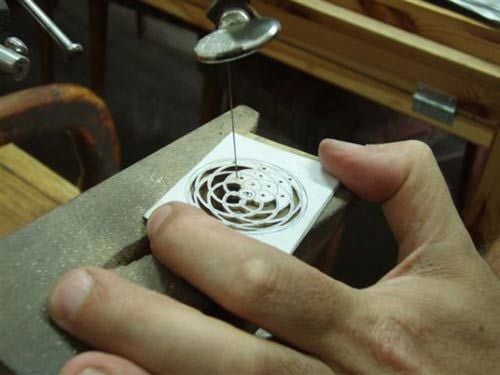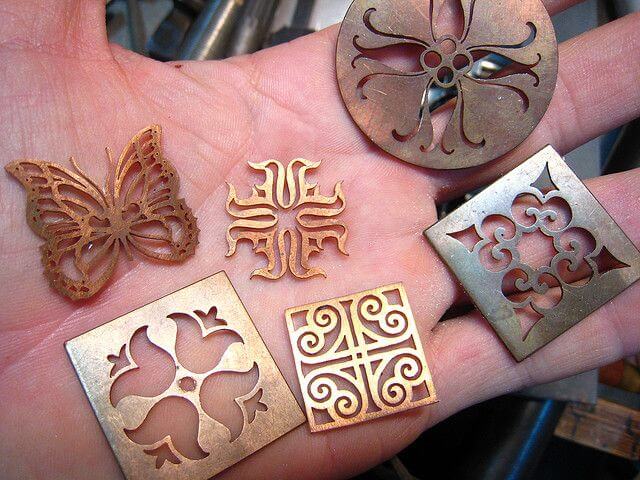
Cutting sheet metal is a fundamental skill that all metalsmiths will need to master before they graduate onto more complex materials and designs in their work. It may seem simple, but learning how to cut sheet metal cleanly and accurately can take practice, but it will stand you in good stead to get the basics right, whatever you’re making. Here are the 5 Hows To Cut Sheet Metal At Home.
5 How’s in Cutting Sheet Metal At Home
1. How to cut sheet metal by hand

Please read our guide below on cutting sheet metal by hand and master sawing and cutting right from the off.
Before you start, here’s what you’ll need:
The basics
- Sheet metal of your choice – start with cheaper materials such as brass and copper when you’re practicing.
- Jeweller’s saw frame – the adjustable frames come in handy because even if you snap a blade, you can adjust the frame and reuse the blade.
- Saw blades – You can pick up saw blades in a range of sizes depending on the thickness of the metal you’re using. Check out our jeweler’s saw blade chart to make sure you pick up the right size blade for the sheet metal you’re cutting.
The nice to haves
- Steel ruler
- Steel square
- Marker
- Saw blade lubricant – this will help you cut cleanly.
- Bench peg and anvil – this will steady your work and your hands as you cut through the sheet metal.
2. How to cut sheet metal cleanly

Now you’re set up with tools and materials; you can get to work. Here’s our step-by-step guide on how to cut sheet metal cleanly and accurately.
Insert the saw blade into the frame
Keep a stock of saw blades on hand.
Loosen the saw frame by twisting the nuts at each end. Now grab one of your saw blades, and place it into the frame, ensuring that the blades are running in the right cutting direction. Gently run your finger along the blade to check this.
Once in position, you can tighten up the end of the saw frame closest to the handle. To make sure the blade is taut, push the end of the saw frame that’s not yet been tightened into your workbench. You’ll see the blade bend a little. At this point, you can tighten the nut at the other end of the frame so that there will be no slack on the blade as you work.
The best way of checking that the saw blade is tight enough is by plucking it as it’s in place – as if you’re plucking a guitar string. The blade should make a pleasant, bright “ting!”.
Mark your sheet metal
Learning how to cut sheet metal at home is all in preparation. If you’re cutting a square or rectangular piece of sheet metal, it’s all about perfectly straight lines. So take your steel square and make sure you’re happy with the line you’re going to cut into before you mark it. Once you’re happy that the line is completely straight, you’re ready to get cutting.
Use your bench peg to steady your work.
With your bench peg in place, you can place your sheet metal so that it’s in a comfortable central position, with the line you’ve made on the sheet metal falling just over the middle notch of your bench peg. This will make it easier to position your saw and cut it cleanly.
Beeswax is the perfect saw blade lubricant.
The first cut of your sheet metal is always the most tricky. Alleviate some of the slippings by creating a notch in your sheet metal using a gentle forward stroke of your saw (away from your body).
Once you’ve made a small notch, you can gently start sawing using just a little pressure. You don’t want to be too heavy-handed as you may break the saw blade – but don’t worry too much if you break a few along the way!
Continue to sew as closely as you can to the line you’ve marked out, keeping an eye on whether you’re straying too close or too far away from the line. Try to use fluid sawing motions and let your hand’s weight do the cutting for you instead of putting too much pressure on the cutting stroke.
As you cut, dust away any small shavings of bits of sheet metal. You can collect this later for scrap. And if you find that your saw blade seems to be getting stuck, add some saw blade lubricant before you continue.
3. How to cut a circle in sheet metal

- Don’t tightly grip your saw handle. Instead, have a loose grip and let your saw do the work for you.
- Don’t push your blade forward into the sheet metal. Instead, hold your saw upright and keep it moving in an up and down motion. This will propel your blade forward and do the cutting for you.
- As you reach curved edges or corners where you need to take turns with your saw, the trick is to keep your saw moving in that up and down motion, but keep it on the spot. Turn the sheet metal instead and keep your blade jogging on the spot, continuing to cut as you move the metal on your bench peg.
- Not happy with one of your curved edges? Come back to it with your saw and place the side of the blade on the point or burr that’s jutting out and needs tidying. Gently jog your saw blade up and down along the side of the burr. This will almost act as a file and a saw blade, removing the excess and tidying up those curved lines.
4. How to cut intricate designs in sheet metal

Are you working on a particularly intricate design in sheet metal that will require detailed sawing and interior cutouts? Hole Punch Pliers will aid more intricate designs.
Here are our top tips on how to cut intricate designs in sheet metal. This will come in handy when you need to pierce your sheet metal to create a cutout effect as part of your design.
- Pierce your sheet metal using either a set of hole punch pliers. If you’re using thicker sheet metal, you may have to move on using a pendant drill instead.
- Once you’ve pierced your sheet metal, you can then remove your saw blade from one end of its frame and thread it through the hole you’ve created.
- Fix your saw blade back into place and secure it tightly.
- Now you can start sawing your intricate cut-out pattern.
5. How to cut sheet metal with a Dremel

If you’ve learned how to cut sheet metal by hand, you may want to speed up your process using a motorized hand tool. Learn how to cut metal with the Dremel 3000 step by step – it will become an invaluable tool to add to your workbench as it’s perfect for cutting sheet metal. It comes with the option of different interchangeable accessories too. So you can cut, finish and polish your jewelry designs with just one tool.
We hope our guide on cutting sheet metal at home has given you the means to master the skill. As you perfect your technique, don’t forget to stock up on the right saw frame and saw blades for the projects you’re working on. 5 How’s To Cut Sheet Metal At Home.
P.S. Royi Sal Jewelry, as a decades-long leader in silver jewelry design and manufacturing, invites you to download our latest magazine here and profit from the exceptional jewelry designs at affordable prices you will find in the magazine. Click here to download it now.
Share this post

